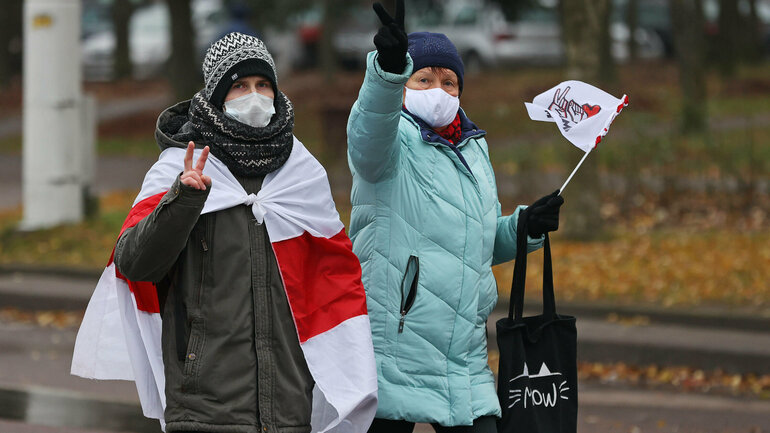Belarus rises: four months and counting

Since 10 August 2020, the day after Belarus’s presidential election, there have been more than four months of mass anti-regime protests in the country. To put this into perspective, these protests have already lasted over 100 days longer than the Egyptian revolution of 2011 and over thirty days longer than the Ukrainian Euromaidan protests of 2013–14.
The Belarusian protests are remarkable not only because they have been taking place for a long time but also because the protesters have not turned to more violent direct action, nor have they occupied central spaces in city centres. This reliance on peaceful protest has continued despite extreme violence and repression by the regime of Belarusian president Aliaksandr Lukashenka. To date, more than 30,000 people have been arrested, more than 1,300 have been severely injured, and dozens have gone missing.
Ongoing research from an online protest survey of Belarusians,[1] conducted by the MOBILISE project, presents a portrait of the typical protester in Belarus. This survey is probably the only comprehensive data source of its kind in the Belarusian context.
Many first-time protesters
Starting in the week of 10 August, ordinary citizens spilled out onto the streets of major cities in a country that many observers had written off as having a deeply entrenched authoritarian regime and a politically apathetic population. The average protester had never previously been involved in protests, was highly unlikely to be a member of an opposition party or organisation, and may not even have voted in the past.
The MOBILISE survey shows that 70 per cent of those who have participated in this year’s protests had never taken part in protests before. Although most participants are protest novices, they are also repeat protesters: on average, each demonstrator surveyed has participated two to four times since first joining in.
The number of protesters at the weekly marches and rallies has declined substantially from about 200,000 at the height of the protests to several thousand by December. But the momentum has been sustained, making the protests the most significant mass mobilisation witnessed in Eastern Europe in recent decades.
The MOBILISE survey shows that about 56 per cent of all protesters are from Minsk. But one of the central features of these protests is their decentralised nature—with regard to both neighbourhood actions in Minsk and protest activities in a range of localities across the country. The typical pattern of protesters travelling to the capital to protest—as seen in Ukraine, for example—is missing in Belarus.
The Belarusian protests are not as leaderless as they appear. The protest leaders are not necessarily synonymous with, or fully represented by, opposition politicians. But many seem to have some protest experience from smaller, earlier demonstrations and are connected via unseen networks.
Fraud and mass arrests as triggers
Two main triggers motivated and mobilised Belarusians to join in the protests. The first was a massive tactical failure by Lukashenka—specifically, the arrest of more than 7,000 people in the first four days of the protests. Ninety-eight per cent of survey respondents were moved to demonstrate because of the government’s mass arrests and widely documented brutality against detainees.
The falsified presidential election result came a close second in terms of protesters’ motivations. The major tipping point occurred on 13–14 August, when a broad coalition of parents, neighbours, and striking factory workers formed in the streets of major cities.
Our data show that while workers’ strikes were a major component in the first two months of the protests, with 20 per cent of respondents having participated in such action, this number has fallen to under 8 per cent currently. According to the survey, 70 per cent of protesters categorise their socio-economic status as having ‘enough money, but to buy expensive things, such as a refrigerator or a TV, we need to save up’. In the Belarusian context, this signals that the protesters are, on the whole, relatively well off. Fewer poorer Belarusians are joining the protests as time goes on.
Demands and prospects
Above all, the protesters’ primary demand is for Lukashenka to step down: just over 35 per cent say they are willing to keep protesting until they see this objective met. Just under 29 per cent want to see more change than just a fresh election and a new leader, expressing their hope for a full democratic transition in Belarus. By comparison, 20 per cent of respondents would be appeased by a rerun of August’s presidential election and are willing to accept the result as long as the vote is free and fair.
A stunning 22 per cent of respondents want to emigrate. The protesters are, on average, relatively wealthy, highly educated, and likely to have the resources to be able to make such a move happen. If the current impasse pushes protesters to leave the country instead of continuing their fight at home, mass emigration might provide a release valve that eases the pressure on the Lukashenka regime to reform. Should this be the case, Belarusians are likely to migrate not only to Poland and Ukraine but also to Russia. This prospect may be an important incentive for the Kremlin to exert pressure on Lukashenka to initiate a transition and resign.
[1] First fielded on 18 August, total n=41,091 [38,565 in Russian and 2,526 in Belarusian] – fully completed n=12,902 [Russian] & n= 835 [Belarusian].
Dr Olga Onuch is a senior lecturer in the School of Social Sciences at the University of Manchester, UK. She is one of the principal investigators of the MOBILISE project, in which ZOiS is a partner institution. She is cooperating on the Belarus protester survey with Prof. Gwendolyn Sasse and Dr Piotr Goldstein, both at ZOiS.